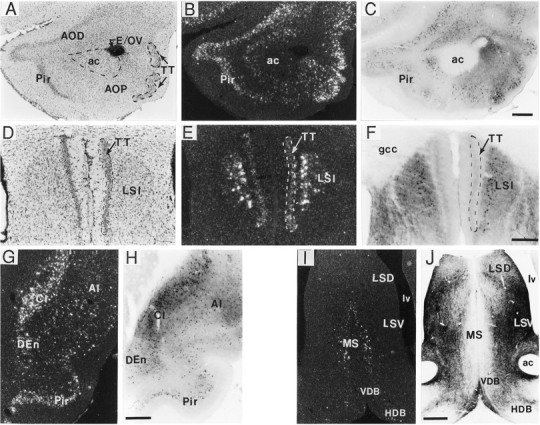Fig. 4.

BDNF-ir and mRNA in forebrain regions.A–J, Sections through the anterior olfactory nucleus (A–C), caudal portion of the tenia tecta (D–F), claustrum and piriform cortex (G, H), and septal region (I, J) processed for immunohistochemistry (C, F, H, J; bright field) and in situ hybridization (B, E, G, I; dark field). Photomicrographs inA and D are of Nissl-stained tissue. Patterns of BDNF-ir and cRNA labeling were very similar in the anterior olfactory nucleus and rostral tenia tecta (TT) (A–C) and, more caudally, in the claustrum (Cl), endopiriform nucleus (DEn), and piriform cortex (Pir) (G, H). In the caudal portion of the tenia tecta, very light hybridization but no immunostaining were observed (D–F); notably heavy hybridization and immunostaining were present in the adjacent intermediate lateral septum (LSI) (D–F). In septal regions, cRNA-labeled cells were seen only in the medial septum (MS), whereas intense BDNF-ir was localized mostly to fibers/terminals in the lateral septum (I, J). Scale bars (shown inC): A–C, 500 μm; (shown inF): D–F, 200 μm; (shown inH): G, H, 500 μm; (shown inJ): I, J, 500 μm.ac, Anterior commissure; AI, agranular insular cortex; AOD, anterior olfactory nucleus, dorsal part; AOP, anterior olfactory nucleus, posterior part;E/OV, ependymal layer/olfactory ventricle;gcc, genu of the corpus callosum; HDB, horizontal limb of the diagonal band; LSD, lateral septum, dorsal part; LSV, lateral septum, ventral part;lv, lateral ventricle; VDB, vertical limb of the diagonal band.
